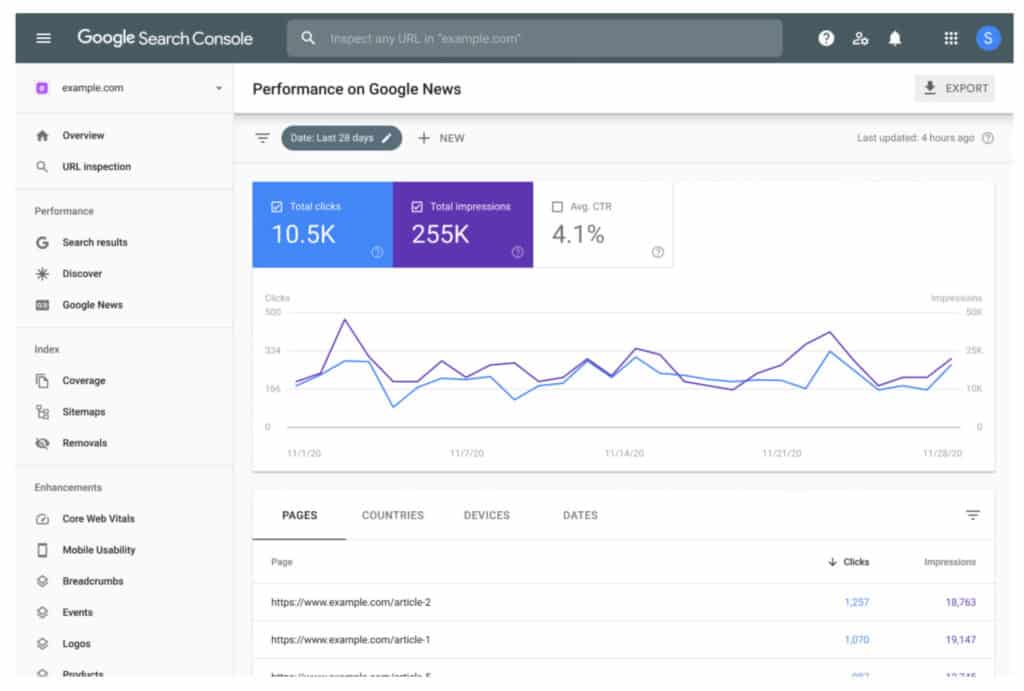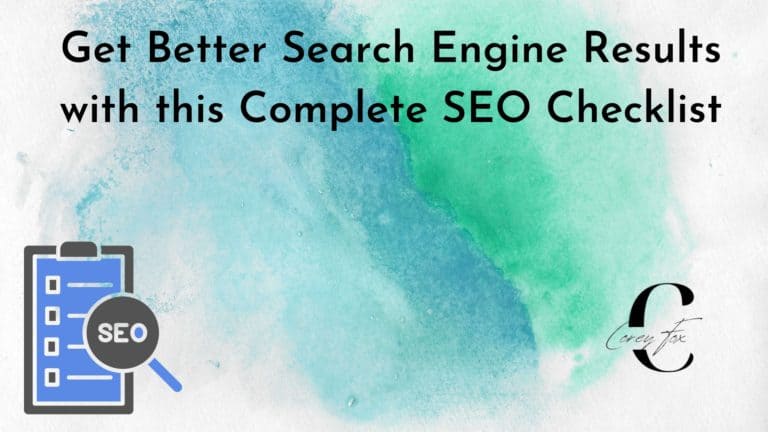Local SEO: How to Optimize Your Website for Local Search
Last Updated on October 3, 2023 by Corey Fox
As online searches have risen, businesses understand the significance of Search Engine Optimization (SEO) to increase visibility and captivate more customers. While traditional SEO seeks to enhance a website’s organic search rankings, Local SEO gets granular by optimizing your site for local searches.
In this blog post, I will dive into what exactly is Local SEO, why it matters so much, and how you can amplify your website’s local rankings.
- What is Local SEO?
- Why is Local SEO important?
- Key Differences Between Traditional and Local SEO
- Google's Local Search Algorithm
- Why Local SEO Matters for Google’s 3-Pack
- How To Find Keywords for Local SEO
- What are The Best Tips to Improve Your Local Searches?
- Tracking Website's Local SEO Performance Over Time
- Common Mistakes Small Businesses Make with Local SEO
- Conclusion
What is Local SEO?
Local SEO is the practice of optimizing a business’s online presence to rank higher in search engine results for geographically related queries.
Unlocking the power of local marketing can help you increase your customer base and revenue. It’s achieved by claiming, verifying, and optimizing a Google Business Profile listing for relevant keywords; building valuable citations and backlinks; plus various other tactics.
With these strategies in place, you’ll create more visibility online to engage with your customers in your area.
The goal of local SEO is to increase visibility and drive traffic to a local business from searches conducted on search engines like Google, Bing, and others.
Why is Local SEO important?
Local SEO is an essential tool for businesses that want to connect with potential customers who are close by and actively searching for products or services.
In this era of mobile devices and location-based queries, optimizing your online presence to accommodate local search has become a crucial part of success.
Here are some of the key benefits of Local SEO:
Increased Visibility
Local SEO helps businesses to appear in the local search results when people search for products or services in your area. This increased visibility can lead to more website traffic, phone calls, and in-store visits from potential customers.
Improved User Experience
Local SEO ensures that the information displayed to users in local search results is accurate and up-to-date. This provides a better user experience for customers and helps to build trust in the business.
Competitive Advantage
By optimizing your website and online presence for local search, you can differentiate yourself from your competitors and stand out in the local market.
Cost-Effective Marketing
Local SEO is a cost-effective way to reach your potential customers who are actively searching for products or services in your area. This type of marketing has a higher return on investment compared to traditional advertising methods, such as print or television ads.
Increased Local Reach
Local SEO helps you to reach your customers who are most likely to become loyal customers and return for future purchases.
Key Differences Between Traditional and Local SEO
Traditional SEO and Local SEO are both important components of search engine optimization, but they have distinct differences.
Here are some key differences between the two:
Target Audience
Traditional SEO focuses on ranking well in organic search results for a wider audience, whereas Local SEO targets customers in a specific geographic location.
Keyword Strategy
Traditional SEO uses keywords to rank well in search results, whereas Local SEO uses location-based keywords and location data to rank well in local search results.
On-Page Optimization
Traditional SEO focuses on optimizing website content and structure to rank well in search results, whereas Local SEO also includes optimization of business information such as name, address, phone number, and business hours to ensure accuracy in local search results.
Off-Page Optimization
Traditional SEO focuses on building backlinks to a website to improve its search engine ranking, whereas Local SEO focuses on building local citations, such as top local business listings in online directories and review sites, to improve the business’s local visibility.
Search Intent
Traditional SEO focuses on providing relevant content to meet the user’s search intent, whereas Local SEO focuses on providing relevant information about the business to users searching for products or services in their local area.
Search Result Display
Traditional SEO results are displayed in the main search results, whereas Local SEO results are displayed in the map pack or local search results.
While traditional SEO and Local SEO share some similarities, they have distinct differences in terms of the target audience, keyword strategy, on-page optimization, off-page optimization, search intent, and search result display.
By understanding the key differences between the two, you can better optimize your websites and online presence to reach both a wider audience and local customers.
Google’s Local Search Algorithm
Google’s local search algorithm is designed to show the most relevant and useful local results to users based on their location and search query.
The algorithm takes into account several factors, such as the relevance of the website to the search query, the distance between the business’s physical location and the user’s location, and the importance of the business as determined by online reviews, backlinks, and other local ranking signals.
Why Local SEO Matters for Google’s 3-Pack
Google’s 3-pack is a feature in Google’s local search results that displays a map with the top three local businesses related to a user’s search query.
These businesses are selected based on relevance, distance, and prominence, and they are displayed prominently at the top of the search results page, making them highly visible to users.
Local SEO matters for Google’s 3-pack because it affects your website’s relevance, distance, and prominence, which are the ranking factors that determine whether your business will be displayed in the 3-pack.
By optimizing your website for Local SEO, you can increase your chances of appearing in the 3-pack and reaching more potential customers in your local market.
Relevance is about how well your website matches the user’s search query. By optimizing your website for relevant local keywords and making sure your NAP information is accurate and consistent across online listings, you can increase your website’s relevance in local search results.
Distance refers to how close your business is to the user’s location. By claiming and verifying your Google Business Profile listing and making sure your NAP information is accurate, you can increase your chances of appearing in the 3-pack for users in your local market.
Prominence refers to how well-known and established your business is in the local community. By acquiring high-quality backlinks, generating positive online reviews, and promoting your website on social media, you can increase your website’s prominence in local search results and improve your chances of appearing in the 3-pack.
How To Find Keywords for Local SEO
Finding the right keywords for local SEO can be a critical factor in optimizing your online presence and driving local traffic to your business. Here are the steps to finding keywords for local SEO:
Identify Your Target Audience
Determining the demographics of your target audience is a key aspect of effective local SEO. By understanding the characteristics and preferences of your target audience, you can create content and campaigns that resonate with them and increase the chances of them becoming customers.
To determine your target audience demographics, consider factors such as age, gender, income, education level, and geographic location. You can use tools like Google Analytics or social media analytics to gather data on your current audience, or conduct surveys and focus groups to gather information directly from potential customers.
Once you have a better understanding of your target audience demographics, you can determine what kind of services or products they are looking for. This information can inform your local SEO strategy by helping you to identify relevant keywords and optimize your website and other online assets accordingly.
For example, if your target audience is primarily young families, you may want to focus on keywords related to “family-friendly activities” or “kid-friendly restaurants” in your area. If your target audience is business professionals, you may want to focus on keywords related to “corporate events” or “business lunches.”
By taking the time to determine the demographics of your target audience and what they are looking for, you can create a more targeted and effective local SEO strategy that will help you reach your desired audience and drive more business to your website.
Conduct Keyword Research
Keyword research is a critical aspect of local SEO, as it helps you to identify the keywords that potential customers are using to search for businesses like yours.
By using a keyword research tool, you can get a better understanding of the search volume and competition for each keyword, allowing you to choose the keywords that are most likely to drive traffic and generate leads for your business.
Google Keyword Planner, Moz Keyword Explorer, and SEMrush are some of the most popular keyword research tools available. These tools provide information on the search volume data for each keyword, as well as the level of competition for ranking for that keyword.
Google Keyword Planner is a free tool that is part of Google AdWords and provides data on the search volume and competition for keywords related to your business.
Moz Keyword Explorer is a paid tool that provides data on keyword search volume, competition, and keyword opportunities, as well as insights on keyword trends and related keywords.
SEMrush is a comprehensive SEO tool that provides data on keyword search volume, competition, and ranking, as well as insights into your competitors’ keyword strategies.
By using keyword research tools, you can get a comprehensive understanding of the keywords that are most relevant to your business and are likely to drive the most traffic and leads.
This information can help you to make informed decisions about your local SEO strategy and optimize your website and other online assets for maximum visibility and impact.
Focus on Local Keywords
Incorporating local keywords into your keyword list is a crucial aspect of local SEO.
By including city, state, or region names, you are making it clear to search engines that your business is targeting a specific geographic location.
This helps to increase the relevance of your website to local searchers and makes it more likely that your business will appear in search results when someone searches for businesses in your area.
In addition to local keywords, it’s important to include more general terms related to your business. These terms should describe the products or services you offer and what makes your business unique.
For example, if you run a bakery, your general keywords might include “baked goods,” “custom cakes,” “coffee shop,” etc.
These keywords will help search engines understand the nature of your business and its relevance to potential customers.
By combining local and general keywords in your keyword list, you can ensure that your website is optimized for both local and non-local searches.
This will increase your visibility and help you reach a wider audience of potential customers.
Consider Long-Tail Keywords
Long-tail keywords are specific phrases that are more targeted and less competitive compared to more generic keywords.
These keywords are often longer and more descriptive, and typically include several words that describe a specific product, service, or location.
For example, instead of using the generic keyword “pizza,” a long-tail keyword might be “best pizza delivery in downtown Los Angeles.” This keyword is more specific and targeted to a specific geographic location, making it more relevant to local searchers.
Long-tail keywords are less competitive compared to generic keywords, which means that it’s easier to rank for them and attract targeted traffic to your website.
Also, long-tail keywords often have higher conversion rates because they attract visitors who are further down the sales funnel and are more likely to make a purchase or take some other desired action.
By including long-tail keywords in your local SEO strategy, you can reach a more targeted audience and increase the chances of attracting high-quality, relevant traffic to your website. This, in turn, can help you to increase conversions and generate more business for your company.
Optimize Your Website
Using the keywords you have identified in your local SEO strategy is crucial to the success of your efforts.
By incorporating your keywords into your website content, meta descriptions, and title tags, you can signal to search engines what your website is about and make it easier for potential customers to find your business online.
However, it’s important to use your keywords naturally and avoid keyword stuffing, which is the practice of cramming as many keywords as possible into your content.
Search engines can detect when keywords are used unnaturally, and this can actually hurt your website’s search engine rankings and reputation.
To use keywords effectively, make sure to integrate them into your website content in a way that sounds natural and provides value to your visitors.
Use your keywords in the following areas:
- Title tags: The title tag is the text that appears in the search engine results and is a crucial factor in determining the relevance of your website to a specific search query. Make sure to include your primary keyword in the title tag of each page on your website.
- Meta descriptions: The meta description is a brief summary of the content on a page that appears in the search engine results. Use your keywords in the meta description to give potential customers an idea of what they can expect to find on your website.
- Website content: Incorporate your keywords into your website content in a way that makes sense and provides value to your visitors. Use your keywords in headings, subheadings, and throughout the body of your content.
By using your keywords naturally and strategically, you can improve your website’s visibility in search engine results and reach more potential customers who are searching for businesses like yours.
Monitor Your Rankings
Tracking your search engine rankings for the keywords you are targeting is an important part of monitoring and evaluating the success of your local SEO efforts.
Regularly monitoring your rankings allows you to see how well your website is performing in search results and to identify any changes or trends that may indicate a need for adjustment.
To track your rankings, you can use tools like Google Search Console, Moz, SEMrush, or Ahrefs.
These tools allow you to see where your website is ranking for specific keywords and to monitor changes in your rankings over time.
This information can help you to identify any changes in search engine algorithms that may impact your rankings, as well as any other factors that may be affecting your website’s visibility in search results.
By regularly tracking your rankings, you can identify areas where your website is performing well and areas where you may need to make adjustments to improve your local SEO efforts.
For example, if you see a decline in rankings for a particular keyword, you may need to analyze your website’s content, backlinks, and other on-page and off-page factors to identify any potential issues and make necessary adjustments.
Stay Up-To-Date
The world of search engine optimization is constantly evolving, with new updates and changes to search algorithms happening all the time.
To succeed with local SEO, it’s essential to stay up-to-date with the latest industry developments and to adjust your strategy accordingly.
One of the best ways to stay informed is to follow industry blogs, forums, and social media accounts related to search engine optimization and local SEO.
This can help you to learn about new updates, changes to search algorithms, and best practices for optimizing your website for local search.
It’s also important to regularly review your local SEO strategy and make any necessary adjustments based on changes in the industry or your business.
For example, if there is a major update to Google’s search algorithm, you may need to adjust your website’s content, backlinks, or other on-page and off-page factors to stay in line with best practices and to maintain a strong local SEO presence.
What are The Best Tips to Improve Your Local Searches?
Improving your local search ranking is crucial to reach your target audience and increasing your visibility in the local search results.
Here are some tips that can help you improve your local search ranking:
Claim Your Google Business Profile (GBP) Listing
Your GBP listing is an essential aspect of your local search engine optimization strategy. It helps Google to understand the location of your business and show it to users searching for similar businesses in your area.
Having a complete, accurate, and up-to-date GBP listing is crucial for improving your local search ranking and visibility.
When you create a GBP listing, you provide Google with information about your business such as the business name, address, phone number, website, business hours, products or services offered, and photos.
This information is used by Google to verify your business’s location and determine how relevant it is to a user’s search query.
If your GBP listing is incomplete or inaccurate, Google may have trouble verifying your business’s location, which can negatively impact your local search ranking and visibility.
Also, if your listing is outdated, it may not accurately reflect your business’s current information, which can lead to confusion and lost business opportunities.
Therefore, it is crucial to regularly review and update your GBP listing to ensure that it is complete, accurate, and up-to-date.
This will improve your local search ranking and help you reach more potential customers in your area.
Encourage Customer Reviews
Encouraging your customers to leave reviews for your business on popular review sites like Google and Yelp can be a powerful tool for improving your local search ranking and establishing trust with potential customers.
Positive reviews from satisfied customers can be a valuable asset for your business, as they serve as social proof of your business’s quality and reputation.
These reviews help to increase the visibility of your business in local search results, as Google and other search engines take into account the number and quality of reviews when ranking local businesses.
The more positive reviews your business has, the higher your business is likely to rank in local search results, which can lead to increased visibility and more potential customers.
To improve your local search ranking, customer reviews also help to build trust with potential customers.
When people search for businesses in your area, they often look for reviews to gauge the quality and reputation of the businesses they are considering.
If your business has a high number of positive reviews, potential customers are more likely to trust your business and choose to do business with you.
Therefore, it is important to actively encourage your customers to leave reviews for your business on popular review sites.
This can be done through in-store signage, email or SMS campaigns, or simply asking them directly for their feedback.
By leveraging the power of customer reviews, you can improve your local search ranking, build trust with potential customers, and drive more business for your company.
Create Posts for Google Business Profile
Once you have access to your Google My Business account, follow these steps to create a post:
- Go to your Google My Business account: Open your web browser and log in to your Google My Business account.
- Select the location you want to manage: Once logged in, you will see a list of all the locations associated with your account. Select the location you want to create a post for by clicking on it.
- Click on the Posts section on the left side of the screen: After selecting the location, you will be taken to the dashboard for that location. On the left side of the screen, click on the “Posts” section.
- Click on the “Write a post” button: This button will be located at the top of the screen and will allow you to create a new post.
- Add text, images, events, offers, or products to your post: You can add a variety of content to your post, including text, images, events, offers, or products. Add the content you want to include in your post and format it as desired.
- Preview your post before publishing: Before you make your post live, preview it to make sure it looks good and all the information is accurate. You can make any necessary changes at this stage.
- Click on the “Publish” button: When you’re happy with your post, click the “Publish” button to make it live.
Note: Posts on Google My Business are short updates that appear on your Google Business Profile and show up in Google Search and Maps. They are a great way to keep your customers informed about what’s going on with your business, including new products, special events, and promotions.
Use Local Citations
Local citations are references to your business’s name, address, and phone number (NAP) that appear on other websites, such as online directories, local business listings, and industry-specific websites.
These citations help search engines to verify your business’s location and increase its visibility in local search results.
Having consistent NAP information is crucial for building a strong online presence and improving your local search ranking.
If your NAP information is inconsistent across different websites, search engines may have difficulty verifying your business’s location, which can negatively impact your local search ranking and visibility.
To ensure consistent NAP information, it’s important to actively monitor your business’s online presence and make sure that your NAP information is accurate and up-to-date on as many reputable websites as possible.
Some of the most important websites to include your business’s NAP information are Google My Business, Bing Places, and Yelp, as well as industry-specific directories and local business listings.
Also, it’s important to regularly check your business’s NAP information on each website to make sure it remains accurate and consistent.
If you need to make changes, be sure to update the information on all relevant websites as soon as possible to maintain consistency.
Focus on High-Quality Backlinks
Backlinks, also known as inbound links or incoming links, link from other websites that lead to your website.
High-quality backlinks from reputable websites can have a significant impact on your local search ranking and help improve your online visibility.
Search engines, such as Google, use backlinks as a way to determine the relevance and authority of a website.
If a website has many high-quality backlinks from reputable websites, search engines are more likely to consider it a valuable resource and rank it higher in search results.
To improve your local search ranking through backlinks, it’s important to focus on building relationships with other local businesses and organizations.
This can include participating in community events, networking with other brick-and-mortar businesses, and collaborating on projects or initiatives.
By building relationships with other businesses and organizations, you can increase the likelihood of obtaining backlinks from relevant and authoritative websites.
It’s also important to obtain backlinks from websites that are relevant to your business and industry. For example, if you run a local restaurant, you may want to obtain backlinks from local food and dining websites, food blogs, and local tourism boards.
These backlinks will not only help improve your local search ranking but also provide additional exposure and drive more traffic to your website.
Optimize Images and Videos
Images and videos can play a crucial role in attracting potential customers and improving your local search ranking. To maximize their impact, it’s important to optimize them with relevant keywords and descriptive captions and make sure they are properly formatted and optimized for search engines.
Keyword optimization involves using relevant keywords in image file names, captions, and alt tags. This helps search engines understand the context and content of the images and videos, and accurately categorize and display them in search results.
In addition to keyword optimization, it’s important to make sure that images and videos are properly formatted and optimized for search engines. This includes ensuring that images are of high quality and resolution, that videos are hosted on reputable platforms, and that they are properly embedded on your website with appropriate alt tags and captions.
By taking these steps, you can help search engines to better understand and rank your images and videos in search results, and attract more potential customers to your website.
Also, properly optimized images and videos can help to engage and retain visitors on your website, which can lead to increased visibility, credibility, and ultimately, more business for your company.
Monitor Your Local Search Ranking
It is crucial to regularly monitor your local search ranking as it provides valuable insights into the effectiveness of your local search strategy.
This means tracking where your business appears in search engine results for relevant keywords and comparing it to your competitors.
By monitoring your local search ranking over time, you can identify patterns and trends in your performance, and use this information to make informed decisions about how to improve your local search visibility.
By tracking your progress, you can assess the impact of any changes you make to your local search strategy, and determine what is working and what is not.
For example, if you make changes to your website’s content or structure, you can monitor the effect this has on your search ranking, and make further adjustments as needed.
Also, regularly monitoring your local search ranking can help you identify areas for improvement, such as optimizing your Google Business Profile listing, improving your online reviews, or updating your business information on directories and other local listings.
Overall, regularly monitoring your local search ranking and tracking your progress over time is essential for maintaining and improving your online visibility, and ensuring that potential customers can easily find your business in their local search results.
Tracking Website’s Local SEO Performance Over Time
Tracking your website’s Local SEO performance over time is crucial for monitoring progress and making data-driven decisions to improve your website’s local search visibility.
Here are some tools you can use to track your website’s Local SEO performance:
Google Analytics

Google Analytics is a free tool that can help you track various metrics related to your website’s traffic, including the number of organic search visits and the source of those visits. You can use this information to see if your efforts are driving more local traffic to your website over time.
Google Search Console

Google Search Console is a free tool that provides data and insights into how your website is performing in Google search results. You can use this tool to track your website’s local search rankings and monitor the position of your website for relevant local keywords over time.
Local SEO Tools
There are several Local SEO tools available, including Moz Local and BrightLocal, that can help you monitor your NAP information and online local listings across multiple directories and platforms.
Review Management Tools
Tools like Podium and BirdEye can help you track and manage online reviews for your business. These tools can provide insights into your online reputation and help you track the number of positive reviews over time.
Common Mistakes Small Businesses Make with Local SEO
Local businesses often make several common mistakes with their Local SEO efforts that can harm their search rankings and reduce their visibility in local search results. Some of the most common mistakes include:
Inconsistent NAP Information
Inconsistent NAP (Name, Address, Phone Number) information across online local listings can confuse search engines and harm your website’s local search rankings.
Lack of Online Reviews
Neglecting to encourage customers to leave online reviews can harm your website’s local search rankings and reduce your credibility in the eyes of potential customers.
Not Optimizing for Mobile
With more and more people using their mobile devices to search for local businesses, it’s crucial to optimize your website for mobile devices. Neglecting to do so can harm your website’s local search rankings and make it difficult for mobile users to find your business.
Ignoring Local Keywords
Neglecting to optimize your website for local keywords can harm your website’s local search rankings and reduce your visibility in local search results.
Duplicate Content
Duplicate content on your website or across multiple online listings can confuse search engines and harm your website’s local search rankings.
Lack of Backlinks
Not having enough high-quality backlinks pointing to your website can harm your website’s local search rankings and reduce your authority and credibility in the eyes of search engines.
Conclusion
Optimizing your website for local search is an essential part of any successful digital marketing strategy.
By focusing on the specific needs of your local audience, you can make your website more visible and accessible to potential customers, and ultimately, drive more traffic and increase conversions.
To get started with local SEO, be sure to claim and verify your Google My Business listing, optimize your website for relevant keywords, and keep your NAP information up-to-date.
With a little time and effort, you can boost your local SEO and help your business reach new heights in the online world.







